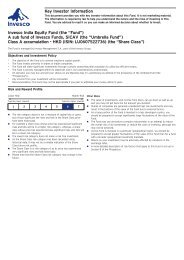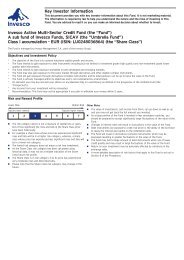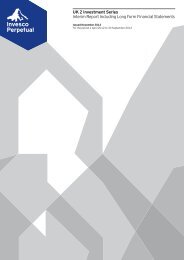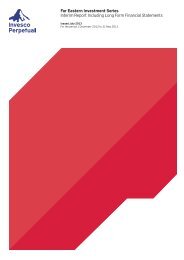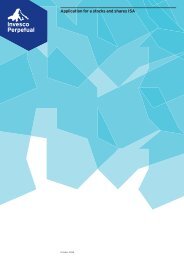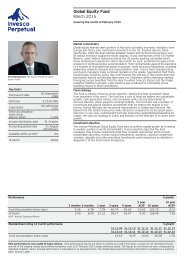Annual report: Period Ended 31 December 2012 - Invesco Perpetual
Annual report: Period Ended 31 December 2012 - Invesco Perpetual
Annual report: Period Ended 31 December 2012 - Invesco Perpetual
You also want an ePaper? Increase the reach of your titles
YUMPU automatically turns print PDFs into web optimized ePapers that Google loves.
City Merchants High Yield Trust Limited 53<br />
19 <strong>December</strong> 2011 to<br />
<strong>31</strong> <strong>December</strong> <strong>2012</strong><br />
£’000<br />
Effect on income statement<br />
Revenue profit 51<br />
Capital loss (4,393)<br />
Effect on net asset value (4,342)<br />
If interest rates had decreased by 1%, this would have had an equal and opposite effect.<br />
The above exposure and sensitivity analysis are not representative of the period as a whole, since<br />
the level of exposure changes frequently as borrowings are drawn down and repaid throughout<br />
the period.<br />
(c)<br />
Other Price Risk<br />
Other price risks (i.e. changes in market prices other than those arising from interest rate risk or<br />
currency risk) may affect the value of the investment portfolio. It is the business of the portfolio<br />
managers to manage the portfolio and borrowings to achieve the best returns.<br />
Management of Other Price Risk<br />
The Directors manage the market price risks inherent in the investment portfolio by meeting<br />
regularly to monitor on a formal basis compliance with the Company’s stated investment policy<br />
and objective and to review investment performance.<br />
The Company’s portfolio is the result of the portfolio managers investment process and as a result<br />
is not correlated with the markets in which the Company invests. The value of the portfolio will<br />
not move in line with the markets but will move as a result of the performance of the underlying<br />
portfolio. The Company can hedge all or part of its investment portfolio denominated in foreign<br />
currency by using borrowings under its revolving credit facility in the same currency. It can also<br />
hold derivative positions in options and futures to hedge movements in the stocks to which the<br />
portfolio has an exposure.<br />
The Company’s exposure to other changes in market prices at <strong>31</strong> <strong>December</strong> on its quoted equity<br />
investments and fixed interest investments was as follows:<br />
<strong>2012</strong><br />
£’000<br />
Fixed asset investments at fair value through profit or loss – Bonds 104,853<br />
– Equity 12,674<br />
117,527<br />
Concentration of Exposure to Other Price Risks<br />
The Company’s investment portfolio on pages 10 to 13 is not concentrated to any single country<br />
of domicile, however, it is recognised that an investment’s country of domicile or listing does not<br />
necessarily equate to its exposure to the economic conditions in that country.<br />
Other Price Risk Sensitivity<br />
At the period end, the Company held equity investments of £12,674,000. The effect of a 10%<br />
increase or decrease in the fair values (including equity exposure through derivatives) on the<br />
profit after taxation for the period is £1,267,000. This level of change is considered to be<br />
reasonably possible based on the observation of current market conditions. The sensitivity<br />
analysis is based on the Company’s equities and equity exposure through derivatives at the<br />
balance sheet date with all other variables held constant.




